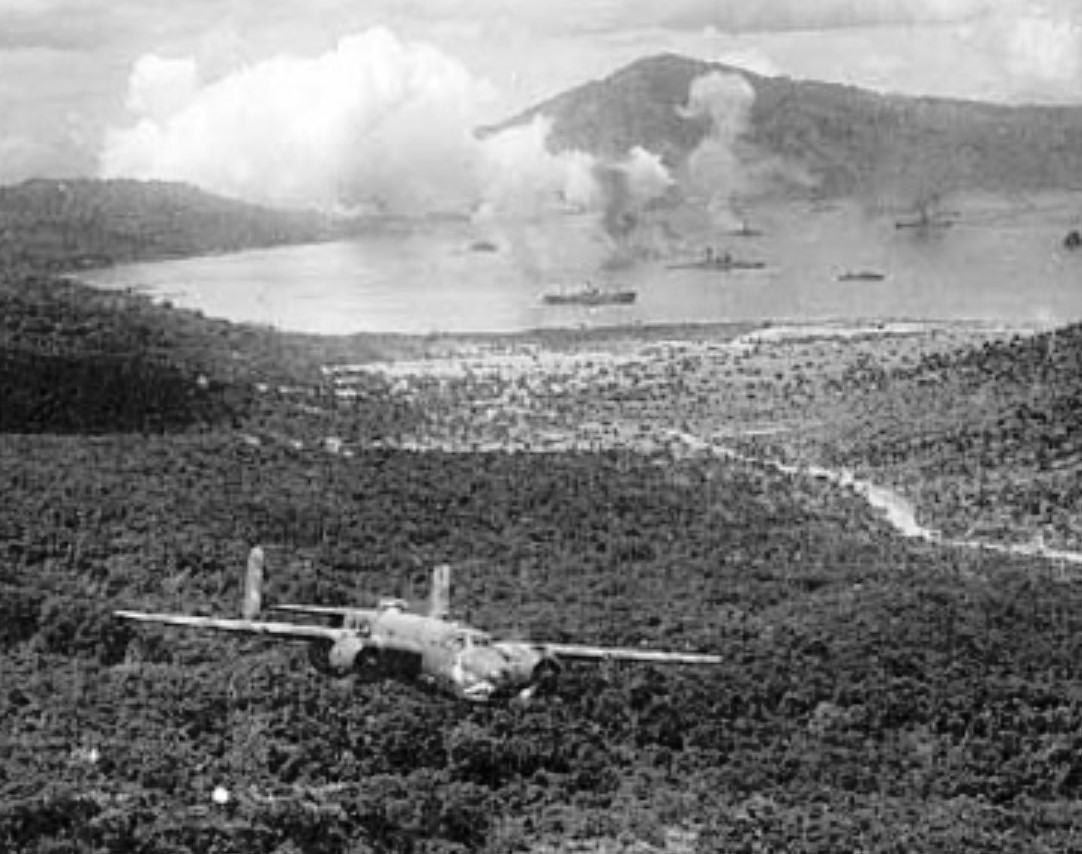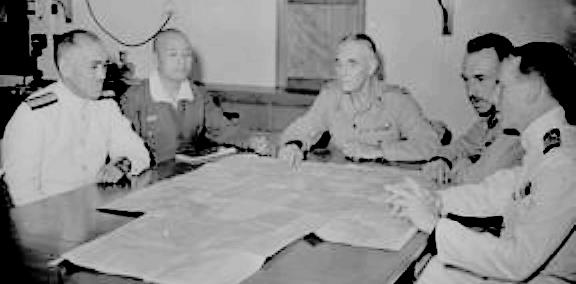Tokusetsu-Kosakubu

at Rabaul, New Britain by Bob Hackett

© 2016-2017 Bob Hackett
Revision 1
On 4 January 1942, Japanese flying boats first bombed Rabaul. On 20 January 1942, Japanese carrier aircraft from Akagi, Kaga, Shokaku and Zuikaku under the command of Vice Admiral Nagumo attacked Rabaul. On 22 January 22, the Japanese invasion force arrived and after midnight, the 144th Infantry Regiment 'South Seas Detachment' landed at several locations. By morning, the Japanese occupied Rabaul.
Due to its position south of their main Pacific supply base at Truk Atoll in the Carolines, the Japanese immediately developed Simpson Harbor into their principal anchorage in the South Pacific, and it as a seaplane operating area with servicing areas at Sulpher Creek and Matupit Island. Japanese built up their presence at Rabaul, making it their advance base for the conquest of the Solomon Islands and Papua, New Guinea. Simpson harbor made an ideal port for transports and warships, while the two airfields served as bases for air operations in the Solomons and New Guinea.
During the war, Rabaul and Simpson Harbor were subjected to Allied aerial attacks starting in February 1942 until the Japanese surrender in September 1945. Allied missions included high altitude bombing raids, medium bombing raids and low level strafing and aerial mining missions The lack of a dry dock and shipbuilding facilities limited Rabaul's ability to provide permanent structural repairs to vessels; however, most other types of repairs were carried out in the harbor alongside damaged ships by the IJN's fleet of repair ships.
On 20 March 1942, 5, 644-ton converted auxiliary repair ship SHOEI (MATSUE) MARU arrived at Rabaul and performed repairs on auxiliary gunboat NIKKAI MARU. The repairs were supervised by SHOEI (MATSUE) MARU's Kosakubucho (Repair Officer) Cdr Takebayashi Chuji.
On 12 May 1942, off New Ireland, USS S-42 (SS-153) sighted minelayer OKINOSHIMA and fired four torpedoes got two or three hits. At 0640, OKINOSHIMA capsized and sank in St. George's Channel, while being towed by destroyer MOCHIZUKI. SHOEI MARU and a trawler were returning to Rabaul after being dispatched to assist OKINOSHIMA, but. USS S-44 (SS-155) fired four torpedoes and two hit portside and sank SHOEI MARU.
On 10 September 1942, Captain/Eng Umekita Shohei was appointed the first Director of the 8th Naval Construction and Repair Department at Rabaul manned by an unknown number of staffers and technicians..In mid-October 1942, 5,110-ton converted auxiliary repair ship HAKKAI MARU arrived at Rabaul and performed repairs on light cruiser TENRYU, destroyer AKIZUKI , auxiliary seaplane tender KIYOKAWA MARU, ammunition ship ONOE MARU and in December 1942, transports KAGU MARU and NANKAI MARU. All such repairs were supervised by HAKKAI MARU's Kosakubucho Captain/Eng Omoto Masazo.
On 2 December 1942, 6,795-ton converted auxiliary repair ship YAMABIKO MARU arrived at Rabaul and performed repairs on destroyer SHIRATSUY U. Among the warships that also received varying degrees of repairs at Rabaul by YAMABIKO MARU in 1942 were destroyers ARIAKE, UZUKI, TACHIKAZE and probably transport (ex-seaplane tender) KAGU MARU. The repairs were supervised by YAMABIKO MARU's Kosakubucho Captain/Eng Tomita Ichiro.
Among the warships that received varying degrees of repairs at Rabaul by repair ship HAKKAI MARU in 1943 were destroyer KAZAGUMO, aircraft transport KEIYO MARU and transports HAKUSAN and NANKAI MARUs. Again, all such repairs were supervised by HAKKAI MARU's successive Kosakubucho Captain/Eng Omoto, Captain/Eng Sakagami Masanobu and Cdr/Eng Shimizu Yoshitaka.
Among the warships that also received repairs at Rabaul by repair ship YAMABIKO MARU in 1943 were cruiser KUMANO, light cruiser YUBARI, destroyers AMAGIRI , HAMAKAZE, HATSUYUKI, ISOKAZE, KAWAKAZE, KAZAGUMO, MAKINAMI, SATSUKI, SUZUKAZE, TACHIKAZE, TANIKAZE, URAKAZE and YUGIRI, minesweeper W-28, aircraft transport KEIYO MARU, transport NANKAI MARU and storeship IJN HAYASAKI . Most of these ships were damaged in actions in the Solomons. All such repairs were supervised by YAMABIKO MARU's successive Kosakubucho Captain/Eng Tomita Ichiro, Cdr/Eng Hasegawa Yoshio and Captain/Eng Sakagami Masanobu.
On 10 June 1943, Captain/Eng Asaka Takeharu was appointed Director of the 8th Naval Construction and Repair Department and served until 15 August 1945.On 12 October 1943, LtGen (later General) George C. Kenney’s 5th Air Force hits Rabaul with the biggest raid made up to then in the Pacific war. 349 aircraft, including 87 B-17 and B-24 bombers, 114 B-25 strafers, 12 RAAF “Beaufighters” and 125 P-38 “Lightning’s” and others from New Guinea and Australia hit Rabaul’s airfields and Simpson harbor. YAMABIKO MARU was not damaged in this raid.
On 2 November 1943, 75 North American B-25 "Mitchell" medium bombers of the 5th Air Force's 3rd, 38th and 345th Bomb Groups, escorted by 70 P-38 "Lightning" fighters raid airfields and Simpson Harbor. Stores ship MANKO MARU is sunk. CruDiv 5’s HAGURO and MYOKO, destroyer SHIRATSUYU, sub tender CHOGEI, transport HOKUYO MARU, stores ship HAYASAKI and minesweeper W-26 are damaged in the raid. W-26 received a direct bomb hit in the engine room and sustained hull damage from near misses. She had to towed to beach to keep from sinking.
SW part of Simpson Harbor. YAMABIKO MARU, anchored close to shore, was hit squarely amidships by either one or two 1, 000-lb bombs. She was set afire and took on a list. One crewman was KIA and 23 WIA.
On 5 November 1943, Rear Admiral (later Admiral) Frederick C. Sherman’s Task Force 38 launched 97 aircraft to attack Rabaul: 23 TBM "Avenger" torpedo-planes, 22 "Dauntless" SBD dive bombers, and 52 F6-F "Hellcat" fighters. SBDs from SARATOGA (CV-3) and PRINCETON (CVL-23) take the Japanese by surprise and damaged CruDiv 4’s ATAGO, TAKAO and MAYA and CruDiv 7’s CHIKUMA and MOGAMI, light cruisers AGANO and NOSHIRO and destroyers AMAGIRI and FUJINAMI. Ten USN planes were lost in the raid.
On 11 November 1943, in the early morning, RAAF Bristol "Beaufort" light bombers and 5th Air Force bombers attacked the harbor, followed about 0830 by aircraft from Rear Admiral Sherman's SARATOGA (CV-3) and PRINCETON (CVL-23) and Rear Admiral (later Vice Admiral) Alfred E. Montgomery's TG 50. 3 carriers ESSEX (CV-9), BUNKER HILL (CV-17) and INDEPENDENCE (CVL-22). 148 F6F-3 “Hellcats”, 24 F4U-1 “Corsairs”, 58 SBD “Dauntless”, 33 SB2C “Helldivers” and 69 “Avengers” took part in the attack. The planes sank destroyer SUZUNAMI and damaged destroyers NAGANAMI, URAKAZE and WAKATSUKI. They also slightly damaged light cruisers AGANO and YUBARI.
During November and December 1943, damaged YAMABIKO MARU's crew performed emergency repairs on their ship and some repairs on the many ships damaged during the previous week's major USAAF and USN air raids. All such repairs were supervised by YAMABIKO MARU's Kosakubucho Captain/Eng Sakagami Masanobu. After receiving temporary repairs, cruiser MAYA and light cruiser AGANO departed Rabaul for Truk where their damage was attended to by repair ship IJN AKASHI.
On 1 December 1943, W-26 underwent repairs alongside auxiliary repair ship HAKKAI MARU.
On 2 December 1943, while anchored, YAMABIKO MARU was bombed. An unknown number of her crew were KIA and 23 WIA.
On 6 December 1943, YAMABIKO MARU was ordered to put her repair machinery ashore at Rabaul and depart for the Empire via Truk to be “fitted out again".
On 22 December 1943, at 0110, YAMABIKO MARU departed Rabaul with Fleet Convoy No. 2222 consisting of YAMAKUNI (ex-YAMAKAZE MARU) and KEIYO MARUs escorted by destroyers OITE and ASANAGI.
On 17 February 1944, W-26 was still beached at Karavia Bay, near Rabaul when USN SBD dive-bombers and TBF torpedo-bombers attacked and sank W-26, cargo ship IWATE MARU and guardboat FUKU MARU No. 2.
On 19 February 1944, the last Japanese ship to enter Simpson Harbor was KOKAI MARU that unloaded barges, ammunition and food, then departed. Afterwards, only submarines managed to deliver small quantities of essential cargo to Rabaul.
On 6 September, 1945, off Rabaul, the Japanese surrendered all remaining forces in New Guinea, New Britain and the Solomon Islands. The ceremony took place aboard light carrier HMS GLORY. Representing the Japanese were General Imamura Hitoshi, Commander 8th Area Army and Vice Admiral Kusaka Jinichi (37), Commander South East Area Fleet. Accepting the surrender of behalf of Allied Forces were Lt Gen V. A. H. Sturdee, GOC First Australian Army witnessed by Brigadier E. L. Sheehan, First Australian Army and Captain Wass Buzzard, RN.

Questions to the author should be posted on the Discussion & Questions board.
-Bob Hackett
